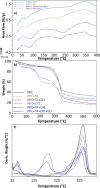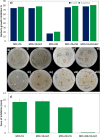Microfibrillated cellulose films containing chitosan and tannic acid for wound healing applications
- PMID: 34117926
- PMCID: PMC8197706
- DOI: 10.1007/s10856-021-06536-4
Microfibrillated cellulose films containing chitosan and tannic acid for wound healing applications
Abstract
The effectiveness of tannic acid as antimicrobial and wound healing for burns have been shown for a century; however, uncontrolled target dosage may result in undesirable side-effects. Remarkably, tannic acid polyphenols compounds crosslinked with polymeric materials produce a strong composite containing the beneficial properties of this tannin. However, investigation of the crosslink structure and its antibacterial and regenerative properties are still unknown when using nanocellulose by mechanical defibrillation; additionally, due to the potential crosslink structure with chitosan, its structure can be complex. Therefore, this work uses bleach kraft nanocellulose in order to investigate the effect on the physical and regenerative properties when incorporated with chitosan and tannic acid. This film results in increased rigidity with a lamellar structure when incorporated with tannic acid due to its strong hydrogen bonding. The release of tannic acid varied depending on the structure it was synthesised with, whereas with chitosan it presented good release model compared to pure cellulose. In addition, exhibiting similar thermal stability as pure cellulose films with antibacterial properties tested against S. aureus and E. coli with good metabolic cellular viability while also inhibiting NF-κB activity, a characteristic of tannic acid.
Conflict of interest statement
The authors declare no competing interests.
Figures







References
-
- Graham N, Gang F, Fowler G, Watts M. Characterisation and coagulation performance of a tannin-based cationic polymer: a preliminary assessment. Colloids Surf A Physicochem Eng Asp. 2008;327:9–16.
-
- Kim TJ, Silva JL, Kim MK, Jung YS. Enhanced antioxidant capacity and antimicrobial activity of tannic acid by thermal processing. Food Chem. 2010;118:740–6.
-
- Pulido R, Bravo L, Saura-Calixto F. Antioxidant activity of dietary polyphenols as determined by a modified ferric reducing/antioxidant power assay. J Agric Food Chem. 2000;48:3396–402. - PubMed
-
- Antonia de SL, Laynne H, de CL, Davi da S, Livio CCN, Jose ADL. Incorporation of tannic acid in formulations for topical use in wound healing: a technological prospecting. Afr J Pharm Pharm. 2015;9:662–74.
-
- Liu H-F, Zhang F, Lineaweaver WC. History and advancement of burn treatments. Ann Plast Surg. 2017;78:S2–8. - PubMed
MeSH terms
Substances
LinkOut - more resources
Full Text Sources
Other Literature Sources

